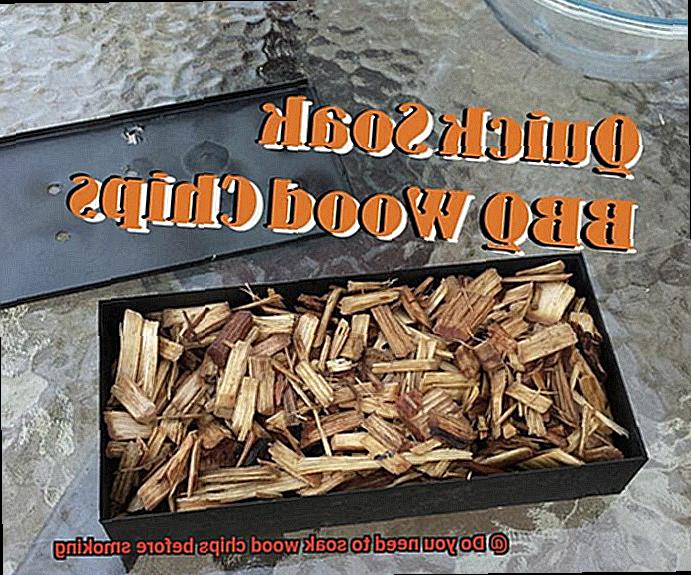Imagine yourself lounging in your backyard on a lazy Sunday afternoon, the tantalizing aroma of smoked meat teasing your senses. You’ve got your smoker ready to go, but there’s one question nagging at you: should you soak wood chips before smoking?
As any seasoned pitmaster will tell you, wood chips are the backbone of any great smoked dish. They infuse meat with that signature smoky flavor and help keep it moist during cooking. But when it comes to soaking those chips, opinions are divided.
Some swear by soaking their wood chips to prevent them from burning too quickly and producing bitter smoke. Others argue that soaking is a waste of time and adds unnecessary steps to the smoking process.
So what’s the answer? In this blog post, we’ll explore the pros and cons of soaking wood chips before smoking and delve into the science behind it all. Whether you’re a novice or a seasoned pro, we’ll help you make an informed decision about whether or not to soak those chips. So grab your apron and let’s get started.
Contents
Benefits of Soaking Wood Chips
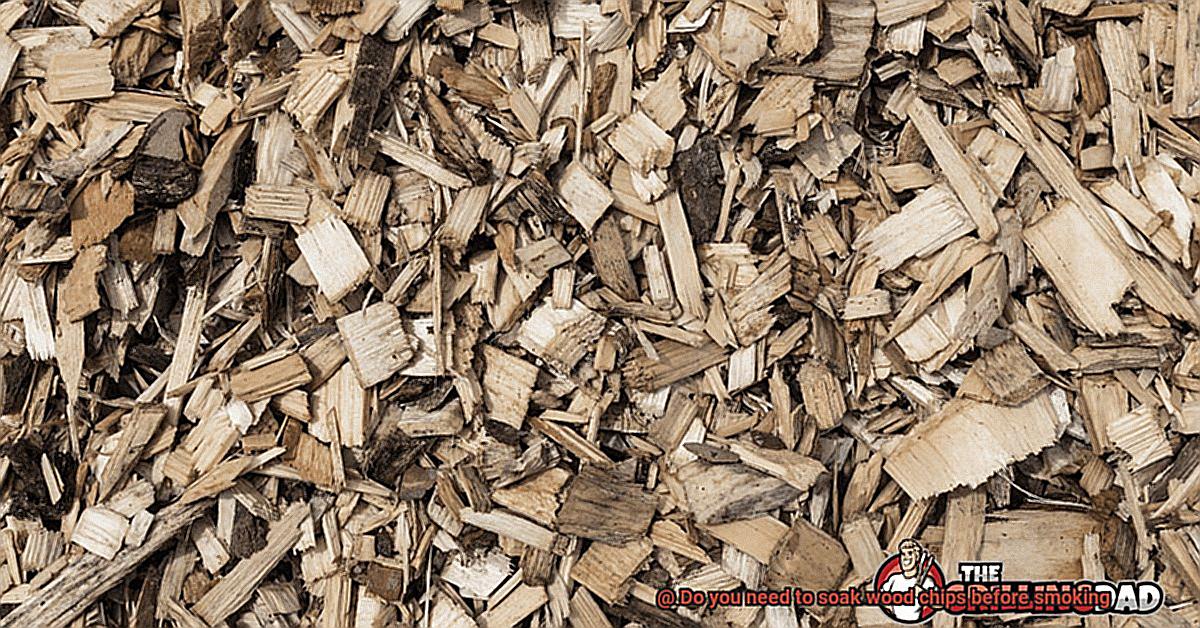
Smoking meat is an art form that requires skill and patience. It’s all about the smoke, and the type of wood chips you use can make all the difference. Many grill enthusiasts swear by soaking their wood chips before using them, claiming it gives their meat a superior flavor. In this post, we’ll explore the benefits of soaking wood chips before smoking meat.
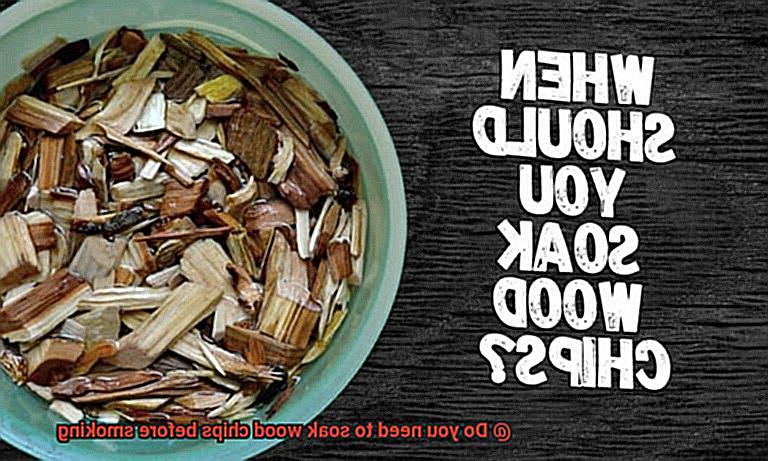
One of the main advantages of soaking wood chips is that it prevents them from burning too quickly. When wood chips burn too fast, they can create excessive smoke, which can ruin the flavor of your meat. By soaking your wood chips in water for at least 30 minutes, they release smoke slowly, resulting in a more consistent and flavorful smoking experience.
Another benefit of soaking wood chips is that it helps regulate the temperature of your smoker. As the water evaporates from the soaked chips, it helps keep the temperature inside your smoker more stable than if you were using dry wood chips.
Soaking wood chips can also enhance the flavor of your smoke by adding different liquids to the soaking water. For example, adding beer or fruit juice to the water can infuse those flavors into your wood chips and ultimately into your meat.
However, there are some potential downsides to soaking wood chips as well. Soaked wood chips may take longer to start smoking than dry ones, so it’s important to plan accordingly and preheat your smoker before adding the chips. Additionally, some grillers believe that soaking wood chips can dilute the natural flavor of the smoke, resulting in less intense smoky flavor.
Ultimately, whether or not to soak your wood chips before smoking is a personal preference that depends on individual techniques and desired outcomes. To help you decide which method works best for you, we’ve compiled a list of pros and cons:
Benefits of Soaking Wood Chips:
- Prevents them from burning too quickly
- Regulates temperature more effectively
- Enhances smoke flavor by absorbing liquids
Drawbacks of Soaking Wood Chips:
- Takes longer to start smoking
- May dilute natural smoky flavor
Drawbacks of Soaking Wood Chips
Soaking wood chips has been a go-to method for grillers and smokers for years. However, if you’re looking for the perfect smoking experience, it’s important to note that this method comes with some significant drawbacks.
Firstly, soaking wood chips can actually hinder the smoking process. When wood chips are soaked in water, they absorb moisture and take longer to dry out. This delay can cause the temperature inside your smoker to drop, leading to longer cooking times and an altered flavor profile that is not ideal.
Another issue with soaking wood chips is that it can lead to inconsistent smoke production. The water in the chips needs to evaporate before smoke is produced, which can result in sporadic bursts of smoke instead of a constant stream. This unpredictable smoking process can ruin your dish and leave you with an unsatisfying meal.
Moreover, soaking wood chips can create unnecessary mess and hassle. Wet chips can be difficult to handle and transfer to the smoker, making the process more time-consuming and frustrating than it needs to be. Excess steam and humidity inside the smoker can also affect the texture of your food, leaving you with a less enjoyable meal.
Thankfully, there are alternative methods for adding smoke flavor to your food that eliminate these drawbacks. Dry wood chips or even wood chunks produce a more consistent stream of smoke without creating excess moisture inside your smoker. These alternatives save you time and effort while providing a better smoking experience overall.
How to Soak Wood Chips Properly
Smoking meat is like an art form that requires patience, skill, and the right ingredients. One of these essential ingredients is wood chips, which add a rich and smoky flavor to the meat. However, the question remains, should you soak your wood chips before using them? Let’s explore this topic in more detail and find out how to properly soak wood chips.
Benefits and drawbacks of soaking wood chips
Soaking wood chips can help prolong the smoking process and allow for more even smoking. Wet wood chips will take longer to reach the temperature required for smoking, which means they will burn slower. Additionally, soaking wood chips can help create more smoke and potentially enhance the flavor profile of the meat.
On the other hand, some experts argue that soaking wood chips can actually hinder the smoking process. When wood chips are soaked, they absorb water which can reduce their ability to produce smoke. This can result in a less flavorful end product. Also, wet wood chips take longer to ignite and may take longer to produce smoke. Additionally, wet wood chips can create steam, which can increase the temperature inside the smoker and potentially dry out the meat.
How to properly soak your wood chips
If you decide to soak your wood chips, here are some steps to follow:
- Choose the right container: Use a container that is large enough to hold all of your wood chips and has a lid to prevent spills. A plastic container with a tight-fitting lid works well.
- Add water: Fill the container with enough water to cover the wood chips completely. Use cold water as hot water can cause the wood chips to break down too quickly.
- Soak for the right amount of time: The amount of time you need to soak your wood chips depends on the size and type of wood you’re using. Generally, you’ll want to soak hardwood chips for at least 30 minutes and softwood chips for at least 15 minutes.
- Drain excess water: After soaking, drain off any excess water from the container. You want the wood chips to be damp but not dripping wet.
- Add wood chips to your smoker: Once your wood chips are properly soaked and drained, add them to your smoker according to your recipe’s instructions.
Different Types of Woods for Smoking
Smoking meat is an art, and choosing the right type of wood is a crucial part of the process. Different woods impart different flavors and aromas to the meat, so it’s essential to choose the right wood for the job. Let’s dive into some of the different types of woods available for smoking and their unique flavor profiles.
Hickory Wood: The Bold and Strong Flavor
One of the most popular choices for smoking is hickory wood. It has a strong and bold flavor that pairs well with all types of meat, particularly pork and beef. Its smoky aroma gives meats a rich and savory taste that’s hard to resist. It’s also commonly used for smoking bacon.
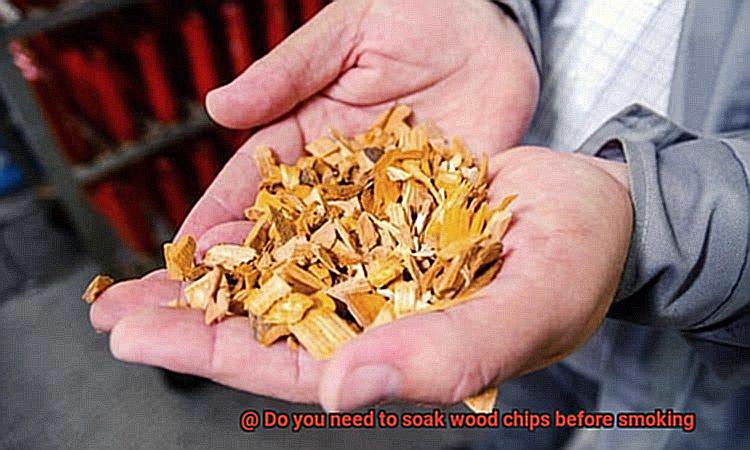
Mesquite Wood: The Intense and Bold Flavor
Mesquite wood is known for its intense, bold flavor that can easily overpower lighter meats. It’s perfect for beef but can also be used on other meats like poultry and fish. Its strong flavor adds depth to your smoked meats, making them stand out from the crowd.
Fruitwoods: The Sweet and Fruity Flavor
Fruitwoods like apple, cherry, and peach are great for smoking lighter meats like poultry or fish. They have a milder flavor compared to other woods, making them perfect for those who prefer a sweeter taste. These woods also add a touch of sweetness to the meat, giving it a delightful fruity aroma.
Oak Wood: The Neutral Flavor
Oak wood is a great option for those who prefer a more subtle smoky flavor. It has a neutral flavor that won’t overpower the natural taste of the meat. It’s also a versatile wood that can be used with any type of meat.
Other Types of Woods
Other types of woods that can be used for smoking include alder, maple, pecan, and cedar. Each of these woods has unique characteristics that can enhance the taste of different types of meats. Alderwood, for example, is great for smoking salmon, while maple wood adds a sweet and smoky flavor to pork.
Tips for Getting the Most Flavor Out of Your Smoked Meats
Smoking meats is an art form that requires attention to detail and an understanding of the science behind the process. One important aspect to consider is the type of wood chips used, as they can greatly affect the flavor of the meat. However, there is often debate about whether or not to soak wood chips before using them in a smoker.
While some people believe that soaking wood chips can help prevent them from burning too quickly and producing too much smoke, others argue that it’s unnecessary and can even negatively impact the flavor of the meat. So, let’s take a closer look at the benefits and drawbacks of soaking wood chips for smoking meats.
Benefits of Soaking Wood Chips
One of the main reasons people soak wood chips is to prevent them from burning too quickly and producing an excessive amount of smoke. Soaking can slow down the burning process and create a more consistent smoke, resulting in a better overall flavor. Additionally, some believe that moistening the wood chips can add moisture to the smoke, which can help keep the meat tender and juicy during the smoking process.
Drawbacks of Soaking Wood Chips
On the other hand, some experts argue that soaking wood chips is not necessary and can actually be detrimental to the smoking process. Wet wood takes longer to heat up, which can delay the start of the smoking process and prolong cooking time. Additionally, wet wood can produce steam that may wash away some of the flavorful compounds in the smoke, resulting in a less intense flavor.
Personal Preference
Ultimately, whether or not you choose to soak your wood chips is a matter of personal preference. Some people swear by it, while others avoid it altogether. If you do decide to soak your wood chips, be sure to do so for at least 30 minutes before using them.
Dry Wood Chips for Maximum Smoke and Flavor
Many experts recommend using dry wood chips instead. Dry wood chips burn evenly and produce the maximum amount of smoke and flavor. When selecting wood chips, be sure to choose a variety that pairs well with the type of meat you’re smoking. For example, apple wood is ideal for poultry, while mesquite is perfect for beef.
The Pros and Cons of Wet vs Dry Smoking
Then, you’ve probably been caught in the age-old debate of wet versus dry smoking. As an expert in this field, I’m here to help you understand the pros and cons of each method, so you can decide which one is best for you.
Wet smoking involves soaking wood chips in water before placing them on the smoker. One significant advantage of this method is that it produces more smoke, resulting in a stronger smoky flavor. The water helps prevent the wood chips from burning too quickly, which can cause a bitter taste in your meat. Additionally, wet smoking helps keep your meat moist as the water from the soaked wood chips evaporates during the cooking process. If you’re after bold and juicy meat that’s full of flavor, then wet smoking may be your go-to method.
However, dry smoking produces a cleaner smoke with less moisture and is beneficial for those who prefer a milder smoky flavor or want to avoid excess moisture in their meat. This smoking technique uses wood chips that have not been soaked in water. It also allows for longer cooking times without needing to add more wood chips. However, one significant drawback of dry smoking is that the wood chips may burn too quickly, resulting in inconsistent smoke production. This problem can be mitigated by using a smoker box or wrapping the wood chips in foil before placing them on the smoker.
Ultimately, whether to use wet or dry smoking comes down to personal preference and experimentation. It’s recommended that you try both methods and see which one works best for your specific recipe and taste preferences.
Here are some pros and cons of wet and dry smoking:
Pros of Wet Smoking:
- Produces more smoke for a stronger smoky flavor
- Helps prevent wood chips from burning too quickly
- Helps keep meat moist during cooking
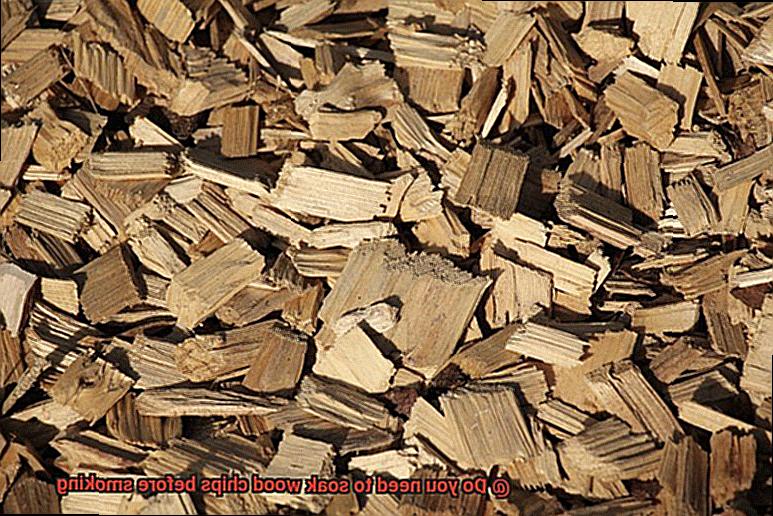
Cons of Wet Smoking:
- May result in excess moisture in meat
- Can cause inconsistent smoke production
- Produces a cleaner smoke with less moisture
- Allows for longer cooking times without adding more wood chips
- May result in inconsistent smoke production
Pros of Dry Smoking:
Cons of Dry Smoking:
Common Mistakes to Avoid When Smoking with Wood Chips
Smoking with wood chips can be a delicious and flavorful way to prepare your food. However, there are common mistakes that beginners often make that can ruin the taste of their smoked dishes. As an expert in smoking, I’m here to share some tips on how to avoid these mistakes and achieve the perfect flavor.
One of the biggest mistakes is soaking your wood chips for too long or not at all. Soaking them for too long can lead to mold growth, which can be harmful to your health. It also causes them to produce steam instead of smoke, resulting in a bitter taste in your food. On the other hand, if you don’t soak them at all, they will burn too quickly, leaving you with little smoke and flavor. To avoid this mistake, try soaking your wood chips for no longer than 30 minutes before using them.
Another mistake is using too many or too few wood chips. Using too many can lead to an overpowering smoky flavor that can ruin your food, while using too few will result in a lack of smoky flavor and aroma. To get the right amount of smoke flavor, use about 1/4 to 1/2 cup of wood chips per hour of smoking.
Lastly, not maintaining a consistent temperature throughout the smoking process is another common mistake. This can cause uneven cooking and absorption of smoke flavor. Make sure to monitor your smoker’s temperature regularly and adjust the vents accordingly to keep a consistent heat.
APLK-C6kdn0″ >
Conclusion
In conclusion, the decision to soak wood chips before smoking is a matter of personal preference and technique. Soaking wood chips can have benefits such as preventing them from burning too quickly, regulating temperature more effectively, and enhancing smoke flavor by absorbing liquids. However, it can also lead to longer cooking times, inconsistent smoke production, and excess moisture in meat. On the other hand, dry wood chips or chunks produce a more consistent stream of smoke without creating excess moisture inside your smoker.
Choosing the right type of wood for smoking is also crucial in achieving the desired flavor profile. Hickory wood offers a strong and bold flavor that pairs well with all types of meat; mesquite wood has an intense, bold flavor perfect for beef; fruitwoods like apple, cherry, and peach are ideal for smoking lighter meats like poultry or fish; oakwood is versatile and can be used with any type of meat.
To maximize the flavor of your smoked meats, opt for dry wood chips instead of wet ones. Avoid common mistakes such as soaking your wood chips for too long or not at all, using too many or too few wood chips, and failing to maintain a consistent temperature throughout the smoking process.
By following these tips and techniques, you’ll be able to achieve the perfect smoky flavor in your dishes every time.

